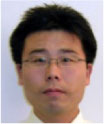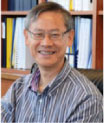The 2nd Molecular Materials Meeting (M3@Singapore)
Yun Zong A C and T. S. Andy Hor A B CA Institute of Materials Research and Engineering (IMRE), Agency for Science, Technology and Research (A*STAR), 3 Research Link, Singapore 117602, Singapore.
B Department of Chemistry, National University of Singapore, 3 Science Drive 3, Singapore 117543, Singapore.
C Corresponding authors. Email: y-zong@imre.a-star.edu.sg; andyhor@imre.a-star.edu.sg

Yun Zong studied chemistry at Wuhan University, China, and Johannes-Gutenberg University of Mainz, Germany. With a scholarship granted by Katholischer-Akademischer Auslaender Dienst (KAAD), he joined the Max-Planck Institute for Polymer Research as a Ph.D. student, working on the development of new photoreactive materials for the construction of highly efficient photoswitching systems in liquid crystal display applications. After receiving his doctorate in science in 2002, he moved to Singapore and joined the National University of Singapore as a post-doctoral research fellow. He has been a staff scientist at the Institute of Materials Research and Engineering (IMRE) since 2004, working on various nanomaterial-based projects. His current research mainly focuses on advanced energy storage solutions. |

Professor Andy Hor is the Executive Director of the Institute of Materials Research and Engineering (IMRE) of the Agency for Science, Technology and Research (A*STAR), Singapore; Professor of Chemistry at the National University of Singapore; President of the Singapore National Institute of Chemistry; and President-Elect of the Federation of Asian Chemical Societies. His main research interests are in organometallic complexes and catalytic materials. He has delivered numerous plenary, keynote and invited lectures in international conferences. He is an Associate Editor (Commissioning) of Aust. J. Chem. and is a member of the international advisory boards of Dalton Trans. (RSC), Inorg. Chim. Acta (Elsevier), and Chem. Asian J. (VCH-Wiley). He has published more than 300 international papers with annual citations of about 550. He has a B.Sc. (Hons) from Imperial College, D.Phil. from Oxford University, and D.Sc. from the University of London, and was a post-doctoral associate of Yale University. |
Australian Journal of Chemistry 65(9) 1191-1194 https://doi.org/10.1071/CH12398
Published: 26 September 2012
A special issue to commemorate the 1st M3@Singapore was published[1] in Aust. J. Chem. 2011, 64 (9) with selected papers presented at the inaugural molecular materials conference. That issue comprised a communication article on temperature-driven molecular self-organization at solution-solid interface,[2] a focussed review on the application of atom-transfer radical polymerization method in the synthesis of polyether-based functional amphiphilic polymers,[3] and original research papers in emerging areas such as dye-sensitized solar cells (DSSCs),[4] metal-organic frameworks (MOFs),[5] light-activated nanoparticle-catalyzed water-splitting,[6] and aggregation-induced emission (AIE) in bioimaging applications,[7] etc. The papers in the special issue reflected the contemporary interests in the broad field of molecular materials.
Encouraged by the resounding success of the inaugural meeting, the Institute of Materials Research and Engineering (IMRE) of the Agency for Science, Technology and Research (A*STAR) hosted the 2nd Molecular Materials Meeting in Singapore (M3@Singapore) from 9 to 11 January 2012. Over 120 talks were presented by distinguished scientists from over 20 countries under the categories of plenary, keynote, invited, and oral lectures. Among the 300 delegates were two Nobel Laureates, Professor Ada E. Yonath (Chemistry, 2009) and Professor Kurt Wuethrich (Chemistry, 2002) who delivered plenary lectures (Fig. 1).
The theme of the 2nd M3@Singapore was ‘Frontiers in Materials Science, Chemistry and Physics’ with 4 sub-themes: 1) Materials Synthesis, Assembly & Device Fabrication; 2) Energy & Sustainable Materials; 3) Optical & Electronic Materials; and 4) Materials for Imaging & Sensing. It was targeted at an audience with a general interest in molecular materials, but with special interest in emerging areas such as sensing and imaging applications. The conference provided a forum for lively discussion and an opportunity for cross-discipline collaboration.
In this commemorative edition of Aust. J. Chem, some papers presented at the 2nd M3@Singapore are featured. Choi et al.[8] (Inha University, Korea) present a focussed review on the recent advancement of electrorheological materials, an important class of materials that transform from liquid-like state to solid-like state by the stimulation of an external electric field. It covers the synthetic methods of nanoparticles that generally have a polymeric core and conducting material-incorporated electro-responsive shell (Fig. 2a), with critical characteristics such as shear stress, yield stress, and dielectric properties. Another review on fuel cells using carbon nanotube-based materials, contributed by Sahoo et al.[9] (Nanyang Technological University, Singapore), summarizes the use of catalytic support for enhanced electrocatalytic activity, the use of metal free electrocatalysts for oxygen reduction reaction, and different types of fillers in electrolyte membranes. Among the original research papers, this issue also features the work of Sakurai et al.[10] (Institute for Molecular Science, Japan), who discovered that alloyed nanoparticles/nanoclusters of Au/Pd with a chitosan-functionalized surface at a given size and Au/Pd ratio present an excellent catalytic property for aerobic oxidative homocoupling of arylboronic acid (Fig. 2b) under acidic aqueous conditions, with near-quantitative yield. Murase et al.[11] (National Institute of Advanced Industrial Science and Technology, Japan) demonstrate that cadmium telluride (CdTe) quantum dots-based hybrid fibres show good potential in the application of low-voltage-driven electroluminescence devices. Ariga et al.[12] (National Institute for Materials Science, Japan) report responsive nanocomposites prepared by in-situ formation of photoinduced Ag nanoparticles in polyacrylic acid matrix that display a reversible shift in the Ag nanparticles’ plasmonic peak maximum when the acidity of their liquid environment changes between water and 0.1M H2SO4 aqueous solution. Such ‘switching’ behaviour are the result of the swelling/shrinking of the acid-responsive polyarylic acid (variation in the degree of deprotonation and thus the repulsion force between polymer segments in the matrix and the material’s volume) that changes the distances between adjacent Ag nanoparticles. This is confirmed by the simulations in both plasmonic spectra (generally known as ‘absorption’ spectra) (Fig. 3a) and the electric field intensity distributions in shrunk (Fig. 3b) and swollen (Fig. 3c) states. These papers show how nanotechnology can be harnessed to introduce new applications for traditional materials.

|

|
Covering the topic of organic energy materials, Li et al.[13] (Wuhan University, China) review the recent progress in the molecular design of heterocyclic-functionalized organic dyes that have good light-harvest features and suppress the interfacial recombination, leading to efficient DSSCs. The correlation of the photovoltaic performance of DSSCs with the chemical structures of the dyes used is a good guide for future molecular designs using this type of material. Among the original papers are contributions by Liu et al.[14] (Institute of Chemistry, Chinese Academy of Sciences, China), who examined the structure–property relationships for phenyl-1H-pyrrole end-capped thiophene semiconductors that are generally used as active layers of organic field-effect transistors; these compounds exhibit clear p-type semiconducting behaviour. Sonar et al.[15] (IMRE, Singapore) report a pyridine-incorporated dihexylquaterthiophene (Fig. 4a) with promising emission properties that can be potentially used as blue emitters in organic light-emitting diode applications. Tang et al.[16] (Hong Kong University of Science and Technology, China) developed a series of carbazole-functionalized poly(1-phenyl-1-alkyne) that can be easily synthesized in high yield. These materials show high quantum yield in electroluminescent devices, and can be easily fabricated into 2D photoluminescent patterns via UV illumination through a copper mask (Fig. 4b). These papers provide good insights into the latest developments of organic semiconductor research.

|
The development of molecular materials has benefited significantly from the enormous progress that has been made in the last decade in molecular science. When the concepts of molecular science are introduced in the design, processing, fabrication and application of standard materials to create new technology through innovation, the impact of research in materials science and engineering takes on a new dimension.
The conference exposes the translational nature of materials research, and its inherent value as an innovation nucleus in many other disciplines, spanning chemical, physical, biomedical, and engineering sciences. Today, according to the ISI Web of KnowledgeSM, Singapore is ranked 6th in the world in the field of materials science among countries that publish more than 1000 papers (12.2 citations per paper in 6110 papers). This is very respectable for a young country involved in science and technology research. Most encouragingly, it shows that Singapore’s research industry is on an upward trajectory path.
The future of molecular materials is limited only by our creativity and how resourceful we are in interacting with other disciplines. New applications will emerge in areas that can capitalize most on this cross-disciplinary fertilization. This is the moment of awakening not only for materials scientists and engineers, but also researchers in areas that are seemingly unrelated to materials science – are there any modern disciplines in science and technology that do not benefit from new materials, new designs, and new processes?
Comparing the size of Singapore with the rest of the world is analogous to comparing a nanoparticulate silica with a grain of sand. The value of this nanoparticle to human civilisation is not measured by its size, but by our imagination. Similarly, how far Singapore can advance in the field of materials science is only limited by our determination and resourcefulness, and, more importantly, how we interact and collaborate with the rest of the world in this human endeavour. The M3@Singapore was established with this mission in mind.
The 3rd M3@Singapore will take place in Singapore from 14 to 16 January 2013 (http://www.imre.a-star.edu.sg/). We welcome all students, researchers and innovators to join us on this expedition that springs delightful surprises at almost every turn.
References
[1] J. K. W. Yang, T. S. A. Hor, Aust. J. Chem. 2011, 64, 1181.| Crossref | GoogleScholarGoogle Scholar |
[2] J. M. MacLeod, F. Rosei, Aust. J. Chem. 2011, 64, 1299.
| Crossref | GoogleScholarGoogle Scholar |
[3] H. Hussain, E. Amado, J. Kressler, Aust. J. Chem. 2011, 64, 1183.
| Crossref | GoogleScholarGoogle Scholar |
[4] W. Zhang, R. Zhu, B. Liu, S. Ramakrishna, Aust. J. Chem. 2011, 64, 1282.
| Crossref | GoogleScholarGoogle Scholar |
[5] R. P. Davies, P. D. Lickiss, K. Robertson, A. J. P. White, Aust. J. Chem. 2011, 64, 1239.
| Crossref | GoogleScholarGoogle Scholar |
[6] K. J. Young, Y. Gao, G. W. Brudvig, Aust. J. Chem. 2011, 64, 1221.
| Crossref | GoogleScholarGoogle Scholar |
[7] Y. Hong, J. Wing Yip Lam, S. Chen, B. Zhong Tang, Aust. J. Chem. 2011, 64, 1203.
| Crossref | GoogleScholarGoogle Scholar |
[8] Y. D. Liu, K. Zhang, W. L. Zhang, H. J. Choi, Aust. J. Chem. 2012, 65, 1195.
| Crossref | GoogleScholarGoogle Scholar |
[9] J. Liu, L. Lai, N. G. Sahoo, W. Zhou, Z. Shen, S. H. Chan, Aust. J. Chem. 2012, 65, 1213.
| Crossref | GoogleScholarGoogle Scholar |
[10] O. Sophiphun, J. Wittayakun, R. N. Dhital, S. Haesuwannakij, A. Murugadoss, H. Sakurai, Aust. J. Chem. 2012, 65, 1238.
| Crossref | GoogleScholarGoogle Scholar |
[11] M. Ando, C. Hosokawa, P. Yang, N. Murase, Aust. J. Chem. 2012, 65, 1257.
| Crossref | GoogleScholarGoogle Scholar |
[12] V. Chegel, A. Lopatynskyi, S. Ishihara, J. P. Hill, K. Ariga, Aust. J. Chem. 2012, 65, 1223.
| Crossref | GoogleScholarGoogle Scholar |
[13] Q. Li, Z. Jiang, J. Qin, Z. Li, Aust. J. Chem. 2012, 65, 1203.
| Crossref | GoogleScholarGoogle Scholar |
[14] Y. Liu, J. Zhang, Y. Liu, G. Yu, Z. Ge, Aust. J. Chem. 2012, 65, 1252.
| Crossref | GoogleScholarGoogle Scholar |
[15] P. Sonar, S. G. Santamaria, T. T. Lin, A. Sellinger, H. Bolink, Aust. J. Chem. 2012, 65, 1244.
| Crossref | GoogleScholarGoogle Scholar |
[16] J. W. Y. Lam, A. Qin, Y. Dong, J. Liu, C. K. W. Jim, Y. Hong, H. S. Kwok, B. Z. Tang, Aust. J. Chem. 2012, 65, 1228.
| Crossref | GoogleScholarGoogle Scholar |



